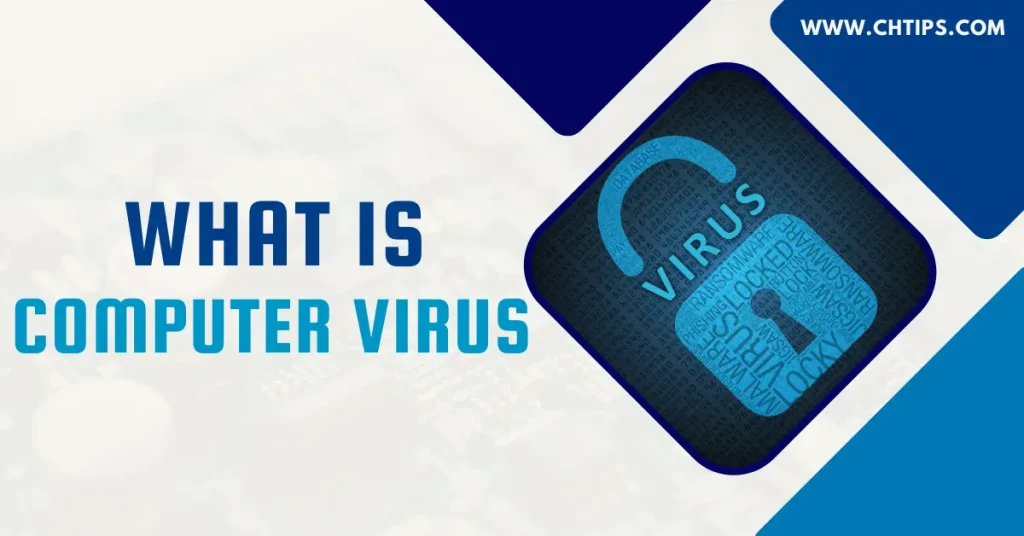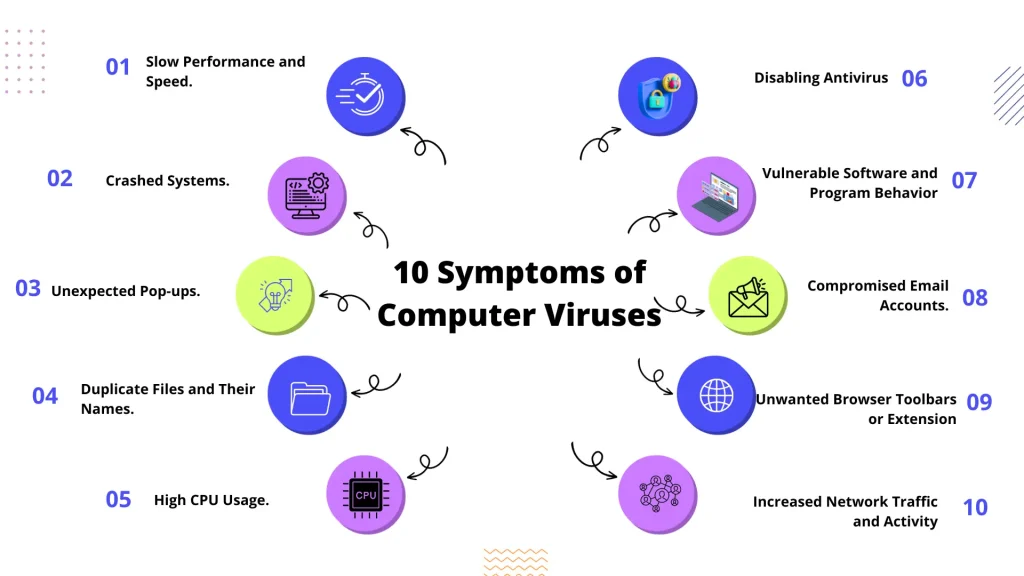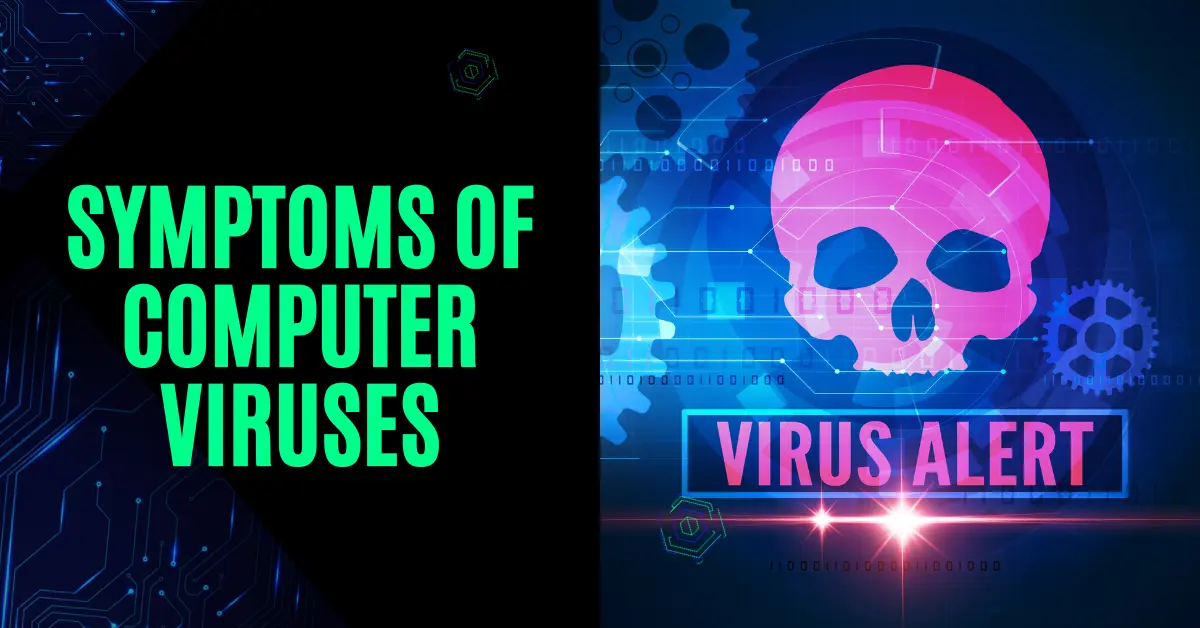Introduction to Computer Viruses
A computer virus is nothing but a program or piece of programming code specially designed and developed to infect the computer system locally and over the network.
These computer viruses can replicate themselves and infect other files and programs present on the hard disk to malfunction or behave abnormally.
Computer viruses are designed to spread over the internet when someone tries to download corrupted files and programs from unauthorized sources.
Today, in this article, we will learn 10 Symptoms of Computer Viruses and how to tackle computer systems infected by computer viruses using antivirus software and preventive measures.
In this world of technology and the rapidly developing digital world, the threat of computer viruses is the most significant and primary concern for computer users.
What is a Computer Virus
A computer virus is a malicious code or program designed and written by a computer programmer to infect a computer system.
These computer viruses can attach themselves to any program or file and later replicate themselves or even infect other files stored on a computer hard disk and over a network that comes in contact with this infected file.

After infecting other files and programs, these viruses try to delete and manipulate the data | information stored in the file.
Some Facts about Viruses.
- Bob Thomas developed the First computer virus at BBN as an experimental project in 1971.
- Brain was also a famous virus developed by two Pakistani brothers named Basit and Amjad Farooq Alvi.
- Mydoom and WannCry are considered the most dangerous viruses in the world.
- Virus stands for Vital Information Resources under Siege.
Various significant features and characteristics of computer viruses are mentioned below.
- Computer viruses are self-replicating and can copy themselves numerous times to corrupt the computer’s operating system.
- Computer viruses can hide inside the computer’s hard disk drive.
- They are designed and developed to spread infection to other files and programs.
- They can spread via emails, downloading songs and movies over the internet from unauthorized sources.
Common viruses are developed to corrupt and infect system executable files such as .exe and essential system files SYS, DLL, OCX, COM, etc.
They are spread by utilizing infected or contaminated media.
When this infected media is taken to the uninfected computer, it gets infected by downloading documents, videos, pictures, and content from the internet containing malicious programs.
10 Symptoms of Computer Viruses in Tabular Form
| # | Symptoms of Computer Viruses |
|---|---|
| 1 | Slow Performance and Speed. |
| 2 | Crash Systems. |
| 3 | Unexpected Pop-ups. |
| 4 | Duplicate Files and Their Names. |
| 5 | High CPU Usage. |
| 6 | Disabling Antivirus. |
| 7 | Vulnerable Software and Program Behavior. |
| 8 | Compromised Email Accounts. |
| 9 | Unwanted Browser Toolbars or Extensions. |
| 10 | Increased Network Traffic and Activity. |
Symptoms of Computer Viruses Using Infographic

10 Symptoms of Computer Viruses in Points
There are various significant major symptoms of computer viruses that are mentioned below.
- Slow Performance and Speed.
- Crash Systems.
- Unexpected Pop-ups.
- Duplicate Files and Their Names.
- High CPU Usage.
- Disabling Antivirus.
- Vulnerable Software and Program Behavior.
- Compromised Email Accounts.
- Unwanted Browser Toolbars or Extensions.
- Increased Network Traffic and Activity.
1. Slow Performance and Speed.
When a computer virus infects any computer system, the performance and speed are degraded and reduced significantly.
This malicious program is designed to run in the background, which eventually consumes more memory, CPU, and other resources, making the computer system stop running to its full potential, and hence, it operates slowly.
These programs reside in the memory, compromising the computer system’s performance.
They can also replicate themselves and make numerous copies that affect network activity and internet speed.
Modern viruses corrupt essential system files of the operating system that are extremely important for the boot process; as these files are damaged, it takes a tremendous amount of time to start.
2. Crashed Systems.
Dangerous and more advanced viruses can easily corrupt and damage the operating system, primarily responsible for the computer system’s total performance and functions.
The operating system is considered the most essential software that bridges the user and computer hardware devices.
The operating system is designed and developed to communicate between other users and the computer system.
As the operating system is essential for any system, damaging it makes it useless, and it is also called a “crashed system.“
Malware programs make the important system files of the operating system unresponsive and unstable.
The OS does not work and function to its full potential and frequently freezes when working.
Some common symptoms can be witnessed when a computer virus infects a computer system.
- Frozen Screens.
- Unresponsive Programs and Applications.
- Regular and Frequent Computer Shutdown.
This malicious code can also raise issues with the hardware and software of any system, such as software problems, hardware failures, device drivers, compatibility issues, etc.
3. Unexpected Pop-ups.
Pop-ups are sudden windows that appear without intentionally triggering them when working on a computer system.
These pop-ups are malicious programs or viruses designed and developed to harm and infect the computer system.
These pop-ups are potentially harmful as they can harm any computer system and steal users’ sensitive information like personal information, credit card details, login credentials, bank details, etc.
Pop-ups are like disruptive advertisements that can hamper user’s computer activity, eventually negatively impacting performance.
These pop-ups are malicious programs that can be used as phishing attacks and display fake and fraudulent advertisements that pop-ups when the user is working online.
These advertisements are displayed with the help of pop-up ads without the users’ consent, violating user consent policy and terms and conditions.
The frequency of these ads irritates and disrupts users, making consumers’ lives more Irritable.
4. Duplicate Files and Their Names.
Modern viruses and malware can make numerous copies of themselves, making computer systems more vulnerable and unstable.
Computer viruses and malware can sometimes change the filename or even the extension of the filename.
This makes the files unreadable and inaccessible.
Making duplicate files can significantly reduce the overall disk space. They also change the file sizes and icons, which causes unexpected changes in the files and programs.
5. High CPU Usage.
Some viruses can increase the overall CPU usage and consume the processor’s resources, which can significantly degrade the computer system’s performance.
These viruses can run from the background using and utilizing processor and CPU resources to consume more computer memory and slow down the system.
Malware carries out DDoS attacks with the utilization of a computer CPU to carry out its activities.
6. Disabling Antivirus.
Antivirus software is considered to be the greatest enemy of viruses. If this legal and premium antivirus software is purchased from authorized sources and updated periodically, it can more than eliminate such harmful viruses and malware.
Antivirus software is built with modern technology, updated virus definitions, and vaults that can quickly identify and clean viruses from computer hard disk drives and external storage devices.
Therefore, viruses and malware try to turn off antivirus software to infect and harm computer systems conveniently.
7. Unexpected Software and Program Behavior.
Common viruses, malware, and malicious code can infect and make software, applications, and files unstable.
They can tamper with essential files of the programs responsible for proper functionality and performance.
The primary cause of any software and program to behave unexpectedly is viruses and malware.
8. Compromised Email Accounts.
Phishing attacks can steal users’ necessary login credentials and compromise email accounts due to unauthorized access.
The malware is designed to steal susceptible information from the user so that they can manipulate and misuse it.
9. Unwanted Browser Toolbars or Extensions.
Some viruses can alter your browser settings and extensions, making them vulnerable to use and handle.
This activity is done without the knowledge of the user.
10. Increased Network Traffic and Activity.
The virus can impact heavy data usage in the network and significantly reduce the computer system’s overall performance and functionality.
How Viruses Affect Computer Systems
Computer viruses are designed, developed, and created for different purposes.
They can damage computer systems in numerous ways, such as causing damage to important system files, disruption, and causing security threats.
Some common ways computer viruses affect computer systems are mentioned below.
- Data Information Corruption and Deletion.
- Degraded System Performance.
- Compromised Security Features.
- Manipulated Files and Programs.
- Network Issues.
- Phishing and Scams.
- Network Failure.
- Corrupt Operating System.
- Ransomware Attacks.
- Unstable Software and Applications.
How Can You Protect Your Computer Against Viruses?
Some common ways to protect your computer against viruses are mentioned. The computer can be kept safe by taking some essential preventive measures.
I’ll write down some of the prevention and preventive measures so that your computer can avoid viruses, malware, and malicious code so that your digital experience can be joyful.
- Legal and Premium Antivirus and Anti-Malware Software Should be Used and Utilized.
- Constantly regularly update your operating system, programs, and software.
- Never Download Software, movies, and Songs from Unauthorized Sources.
- Always Scan External Storage Devices with Antivirus Software to Eliminate Viruses and Malware.
- Apply Firewall Protection and Network Security Measures.
- Educate Users about Safe Browsing Habits and Cybersecurity Awareness.
- Never visit pornographic websites, as they contain malicious programs that can hurt or damage system files or operating systems.
- One must not Download Pirated Software that May Contain a Malicious Program.
- It would help if you scanned any USB medium before using it.
- Always beware of phishing attacks that generally happen when clicking on websites that are not authenticated.
How to know if Your Computer Has a Virus Windows 10
When a computer is infected or contaminated with a virus, the computer displays some of the common signs and symptoms.
If a user closely monitors the computer’s symptoms, you can quickly diagnose whether your computer is infected.
Below, I have mentioned some steps so that users can quickly identify virus infections on their computers.
- Scan computer hard disk drives or external storage media with legal and updated antivirus software.
- Keep an eye on unusual computer behavior.
- Duplicate files and programs.
- Frequently crashed operating system.
- Software and application vulnerabilities.
- Slow speed and performance.
- Check and task manager to locate any suspicious and doubtful processes and tasks.
- Vulnerable Startup Process.
- Use legal malware software so that you can check the infection.
How Can I Delete Virus from My Computer Without Antivirus?
Identifying and eliminating viruses from computer systems with antivirus can be a lot of work.
Some common steps can be used to clean the computer system.
- Reboot the computer in safe mode.
- Check startup programs and turn off any suspicious code or program.
- Delete unwanted programs, files, and applications.
- Check the task manager for any unusual activity.
- Delete temporary files and folders.
- Manually delete unused browser extensions and tools.
The tips mentioned above need to be more foolproof. They can only used as a precautionary measure.
Please use legal antivirus software and take professional advice to eliminate viruses from your computer.
Helpful Video: Symptoms of Computer Viruses
10 Most Famous Computer Viruses
- Brain Virus.
- ILOVEYOU.
- Code Red.
- Slammer.
- Conficker.
- Stuxnet.
- WannaCry.
- CryptoLocker.
- NotPetya.
- Mydoom.
10 Symptoms of Computer Viruses PDF Download
Do You Know What Will Happen if Your Computer Gets Infected With a Virus
Some common signs a computer presents when a computer virus infects it can be summarized as follows:
- Data Loss.
- Security Threats.
- Network Errors.
- Identity Theft.
- Unauthorized Access.
How Can I Check My Computer for Viruses for Free?
Yes, you can achieve this by using some free resources available over the internet.
Below, I have provided five techniques to check my computer for viruses for free.
- Windows Defender.
- Malwarebytes (Free Version).
- Avast Free Antivirus.
- AVG AntiVirus Free.
- Sophos Home Free.
Related Articles
- Advantages and Disadvantages of Antivirus Software
- What is a Computer Virus & Their Types
- What is the First Computer Virus In Philippines
- Explain 6 Classification of Computer
- 10 Uses of Multimedia in Different Fields
- Advantages and Disadvantages of Firewall
- Computer Basic Tutorials
Top 5 Antivirus Companies That Can Help You Remove Viruses From Your Computer
- Bitdefender
- Norton
- Webroot
- McAfee
- TrendMicro
- Malware Bytes
- Quick Heal
- Kaspersky
- Net Protector Antivirus
Different Types of Computer Viruses
- System Viruses
- Trojan Viruses
- Macro Viruses
- Worms
- File Viruses
- Boot Sector or Boot Record Viruses
Frequently Asked Questions [FAQs]
10 Greatest Computer Virus?
WannaCry.
MyDoom.
ILOVEYOU.
Sobig.
Zeus.
Conficker.
Klez.
Stuxnet.
CryptoLocker.
What are the four most common computer viruses?
Resident Virus
Web Scripting Virus.
File Infector.
Network Virus.
What are the four symptoms of viruses?
Slow Performance.
Unusual Behavior.
Operating System Crash Frequently.
Vulnerabilities in application and programs.
Which is the first computer virus?
Creeper was created in 1971 by Bob Thomas of BBN.
Who is the father of computer viruses?
Von Neumann.
What is the full form of virus?
Vital Information Resources under Siege.
Get In Touch
Users should pay attention to system behavior so that any symptoms of computer viruses can be noted, and later, they can take appropriate action to eliminate and clean the system.
Eliminating and cleaning the system from viruses and malware is a good practice to keep the system up to date and maintain a good performance with better functionality.
After taking necessary actions, users can be free from data and information loss, identity theft, network errors, and slow and downgraded speed with performance after taking essential actions.
These actions can also prevent users from avoiding and stealing sensitive information from malicious programs.
New and more advanced viruses, malware, and malicious code are released over the internet almost daily, so to tackle this, users need to educate themselves and use legal antivirus and anti-malware software.
I have also written and compiled some articles on computers and telecommunications, and please go through them.
I hope you will like reading it.
All the questions and queries related to the 10 Symptoms of Computer Viruses are answered here.
If you have any questions about the signs of computer viruses and how to eliminate them?
Don’t hesitate to contact me, and if you feel like adding, removing, or updating anything from the article,
Please let me know in the comment section or via email.
I will be more than happy to update the article. I am always ready to correct myself.
Please share this article with your friends and colleagues; this motivates me to write more related topics.
!!! Thank You For Reading !!!
